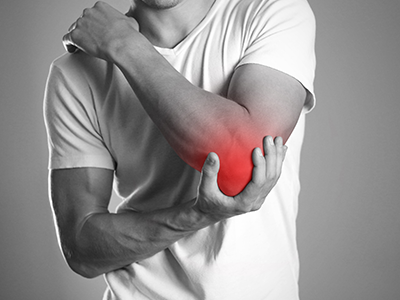Physio For Elbow Pain – Tennis Elbow

Tennis elbow, or lateral epicondylitis, is not just a problem for tennis players. It was originally described as an injury related to the backhand swing in tennis, but now it is commonly associated with other repetitive activities including mousing, keyboarding, carrying bags, manual work, or using a variety of tools around the house. All of these activities can strain the muscles and tendon attachments of the elbow to produce tennis elbow symptoms. In the clinic we often see a lot of tennis elbow pain in people after they have participated in an activity that they are unaccustomed to such as a new sport or hobby such as digging the garden or painting.
Where Is Tennis Elbow Pain Felt?
Tennis elbow gives you pain on the outside bump of the elbow, called the lateral epicondyle. The forearm muscles that bend the wrist back (the extensors) blend into what is known as the common extensor tendon that attaches onto the lateral epicondyle. Because a lot of muscles pull through this relatively small attachment point it is prone to injury, especially as the blood supply here is quite poor so healing potential is reduced. If you have pain to touch over the lateral epicondyle, pain with gripping and some angles of lifting, or/and pain while bending the wrist backwards, then you may well have tennis elbow.
What Is Tennis Elbow?
Tennis elbow pain is due to excessive strain causing microtrauma to the attachment of the common extensor tendon to the lateral epicondyle. In an acute injury the body undergoes an inflammatory response where special inflammatory cells make their way to the injured tissue to help the healing process. However, tennis elbow does not always involve active inflammation. Instead, with ongoing strain and microtrauma the tendon can undergo changes in its structure (cellular and matrix composition) which we call tendinopathy. Although there is no significant ongoing inflammatory process these structural changes can lead to ongoing pain and changes in sensation, strength and muscle recruitment.
Physiotherapy Treatment For Tennis Elbow
After completing a thorough assessment, your physio will provide you with an accurate diagnosis of your injury and a clear plan for your recovery. They will highlight all the major milestones and timelines that you will go through during your treatment program. Your recovery plan will include four major phases:
- Pain control plus restoring muscle length and range of motion
- Specific strengthening of the elbow, wrist and hand muscles and tendons
- Optimising biomechanics and functional strengthening, including the shoulder girdle
- Advanced strengthening and return to sport
Your recovery plan and treatment will always be individualised and tailored for your needs. If you have been feeling pain for several months or more then it may take some time, sometimes a few months, to really relieve it. Often the pain that you felt with relatively light daily activities can resolve quite quickly, however heavier loading activities like tennis, digging the garden, lifting heavy things and some gym exercises may take substantially more time.
Initially your treatment will include
specific hands-on techniques, or manual therapy, to reduce your
pain, restore your muscle length and normalise your joint range of motion.
Sometimes we may also use taping or a brace to help control symptoms. Graded
exercises are also used extensively right from the start, focusing on putting
the right load through the tendon to promote healing as well as releasing
techniques to restore muscle length.
As with any tendon injury or tendinopathy,
completing a structured strength program is crucial to your lasting recovery.
Research clearly shows that a tendinopathy, especially if it has been there for
some time, requires a progressive loading program to maximise the tendon’s
ongoing ability to deal with tension and strain. Failure to do this usually
leads to persisting or recurrent pain, and a gradually worsening prognosis.
Your physio will provide you with a comprehensive exercise program to guide you
safely back to all of your normal daily activities as well as your chosen sports,
exercise and hobbies.


